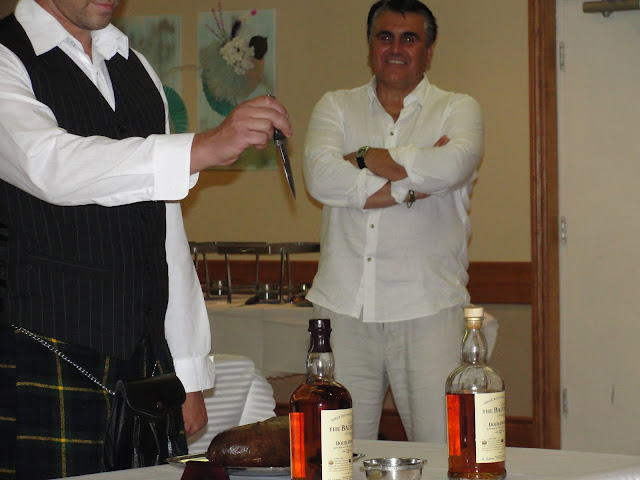 |
| One of my uncles and my cousins (sister of the bride) playing the pipes |
As I said in an earlier post, one of my cousins’ daughters got married on the beach at Sanibel Island on the west coast of Florida about three weeks ago and had her wedding reception in a small town north of Toronto last night to which I took my mother and two of my daughters. This is the Scots part of the family and they did the whole Scots thing including the haggis and pipers (one of my uncles with his granddaughter at the pipes.)
 |
| At the start of the address to the Haggis |
The Selkirk Grace done at the beginning of the wedding reception.
Some hae meat and canna eat,
And some wad eat that want it;
But we hae meat, and we can eat,
And sae let the Lord be thankit.
 |
| Ready to cut the haggis during the address. |
For those of you who haven’t heard the Address to the Haggis below is a rendition of the Address to the Haggis.
From Wikipedia:
Haggis is a dish containing sheep’s 'pluck' (heart, liver and lungs), minced with onion, oatmeal, suet, spices, and salt, mixed with stock, and traditionally simmered in the animal's stomach for approximately three hours.It’s traditional to make the address to the haggis at the wedding reception using Robbie Burn’s poem and then toast the haggis with a drink of Scotch whiskey. After drinking, you turn the drinking cup upside down over your head to prove that you’ve drunk the entire amount. The main course is haggis, and is traditionally served with mashed potatoes (tatties) and mashed turnip (neeps).
 |
| Pouring the Scotch whiskey for the toast to the Haggis. |
Also from Wikipedia:
In the absence of hard facts as to haggis' origins, popular folklore has provided more fanciful theories. One is that the dish originates from the days of the old Scottish cattle drovers. When the men left the highlands to drive their cattle to market in Edinburgh the women would prepare rations for them to eat during the long journey down through the glens. They used the ingredients that were most readily available in their homes and conveniently packaged them in a sheep's stomach allowing for easy transportation during the journey. Other speculations have been based on Scottish slaughtering practices. When a Chieftain or Laird required an animal to be slaughtered for meat (whether sheep or cattle) the workmen were allowed to keep the offal as their share.
 |
| Bride drinking the toast to the Haggis. |
 |
| Haggis, tatties and neeps. |
 |
| Live band including the bride. |
 |
| Mother and two of my daughters |
 |
| Wedding cake |
No comments:
Post a Comment